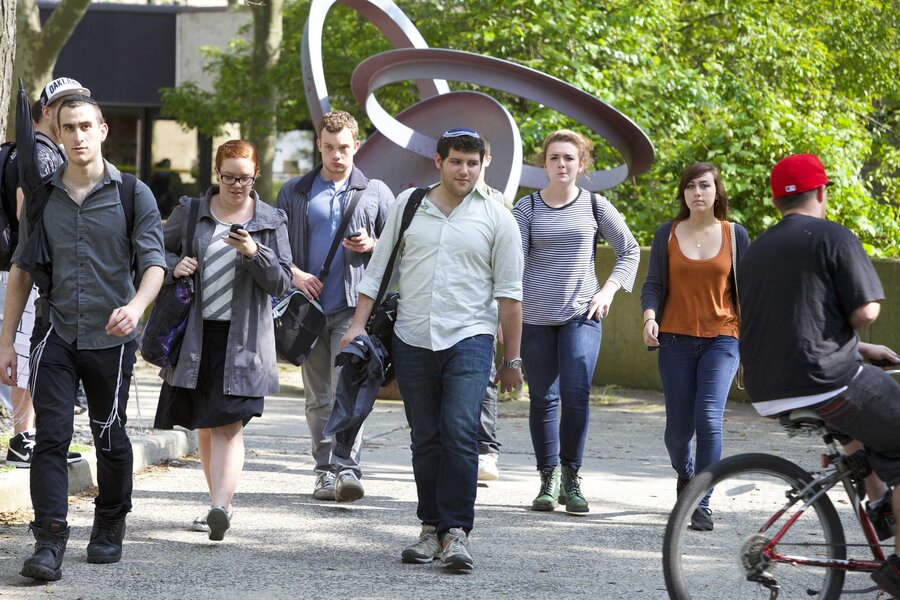Why Cal State L.A. turns the most low-income students into top earners
Loading...
In many ways, George Pla is the embodiment of the American dream.
The son of Mexican immigrants, Mr. Pla moved to Los Angeles’s Boyle Heights neighborhood at 5 years old. One of five children growing up on the $100 a month his father earned doing construction work in the 1950s, Pla says he always dreamed of attending “the college on the hill.”
That college was California State University, Los Angeles, a mid-tier public university that he credits with his rapid ascent up the income ladder.
“Without Cal State L.A., I’m nowhere,” says Pla, who initially got his foot in the door at an East Los Angeles community college. After two years he transferred to Cal State, where he graduated in 1972 before going on to get a graduate degree in public finance from the University of Southern California.
Today, Pla is the founder and CEO of a nationally recognized civil engineering firm, Cordoba Corp. He employs more than 200 people and builds major infrastructure projects for California’s transportation, education, water, and energy sectors. With a base salary of more than $1 million a year, Pla’s story and others like it are held up as the pinnacle of the American Dream. His alma mater, Cal State, Los Angeles, launches more low-income kids into the top income bracket than Harvard, according to a new study by a group of high-level academics working under the title The Equality of Opportunity Project.
For decades, “working-class” colleges like Cal State have been one of the more reliable engines of economic mobility. And, the new research shows, public higher education systems like those in California, Texas, and New York still push low-income kids into the top echelon of earners at far higher rates than the eight Ivy League colleges, plus the University of Chicago, Stanford, Massachusetts Institute of Technology, and Duke University. (The researchers called this the "Ivy-Plus.")
Sixty percent of Ivy-Plus students from the lowest income bracket reach the top, but the mid-tier colleges beat them on the upward-mobility metric because they accept so many more poor students, and those students still reach the top income bracket at comparable rates. For example, 51 percent of the State University of New York, Stony Brook’s, lowest-quintile students make it to the top economic quintile.
But now, authors of the report – Mobility Report Cards: The Role of Colleges in Intergenerational Mobility – say those successes are being significantly hampered. Over the past 15 years, the number of low-income students enrolling at mid-tier universities has been on a downward slide. As such, they say, their new data serves as a timely warning to policymakers and educators for the need to bolster support for high-performing mid-tier institutions. Furthermore, they say, it highlights the need to study what makes top performing public systems so successful so their models can be replicated across the country.
“What we've seen is that the colleges that we identify as being very good by our metric, which in many cases includes these mid-tier public schools are in most cases declining in terms of access,” says Robert Fluegge, a pre-doctoral research fellow at Stanford University, who worked on the study. “They've seen the proportion of poor students decline pretty substantially, and I think that that's a bit worrisome, given that these are the colleges that are really doing well for poor students.”
Top five schools for mobility
The research, based on administrative data of 30 million American college students between 1999 and 2013, showed the colleges with the top five upward mobility rates in the nation: Cal State LA was first (9.9 percent). The State University of New York (SUNY), Stony Brook (8.4 percent); City University of New York’s system (CUNY) (7.2 percent); California’s Glendale Community College (7.1 percent); and University of Texas, El Paso (6.8 percent), rounded out the top five. To put those numbers in perspective, the average upward mobility rate across all US colleges is less than 2 percent.
Pla was pleased to see that his alma mater topped the upward mobility rankings, but as someone who has stayed philanthropically involved with the state’s higher education system, he knows firsthand that it’s getting harder for people from backgrounds like his to find their way into such schools.
“Thank God that public education used to be accessible and affordable, and we have really got to fight to keep it that way,” Pla says. "I think an institution like Cal State is absolutely golden.”
Indeed, the study’s sample group revealed a bittersweet picture. On the upside, America’s poorest students are attending college at record rates. Overall college attendance for low-income students over the study’s sample period climbed about 2 percentage points, according to John N. Friedman, an associate professor of economics and international and public affairs at Brown University and co-author of the research. However, at the same time, their access to schools that improve students' upward economic mobility fell by 2.5 percentage points.
“What our research really points out is that not all community colleges are created equally,” Professor Friedman says. “There are important differences both in the fraction of students from poor families and in the outcomes across different community colleges, and I think it's probably very important, whether you go to a Cal State university or to another California community college.”
Alma mater as predictor of earnings
In other words, access is everything. Friedman says that what particularly stands out to him is that once a low-income student gains access to a good college, whether an Ivy League or a good mid-tier, there’s very little difference in their performance compared with those of their peers from wealthy backgrounds.
“One of the really striking findings of the study was, that you would in some sense really rather know where somebody went to college rather than how much money their parents make, if you wanted to guess how much money they were going to make in the future,” Mr. Fluegge adds.
The need to bolster and spread access to quality secondary education is highlighted by America’s continual downward trend in upward mobility. Children born in the 1940s had a 90 percent likelihood they would grow up to earn more than their parents, for those born in 1980, it’s a 50/50 prospect, according to another paper by the Equality of Opportunity Project, released late last year.
And the implications for America’s severe income inequality are substantial. As David Leonhardt points out in The New York Times, the earnings gap between four-year college graduates and the rest of the population has boomed in recent decades. The unemployment rate for college graduates is only 2.5 percent, compared with a national average close to 5 percent.
The broad consensus among education watchers is that rising tuition costs along with massive state budget cuts are the main culprits. For Friedman, the research is a solid start, although follow-ups looking at the effects of things like budget cuts, students’ college preparedness, and education policies that enable easy transfers from community colleges to universities, just as Pla did when he went to Cal State, are needed.
“By identifying these schools and drawing attention to them hopefully it'll lead to follow-up research where we can identify what makes the City University of New York or the Cal State systems so outstanding in a way that we can find a model to replicate at other schools.”
Editor's note: An earlier version of this story incorrectly stated that David Leonhardt was a professor at New York University Steinhardt.








